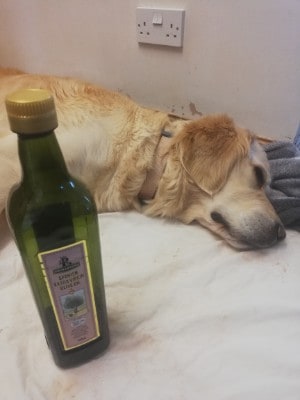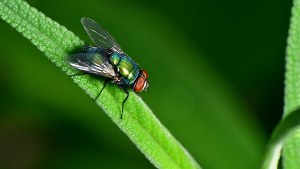
Olive oil is rich in powerful antioxidants, vitamin E, K and many other anti-inflammatory compounds.
It also contains omega-3 and omega-6 fatty acids which are excellent for heart health and monounsaturated fats which makes it heat-resistant and great for cooking.
Olive oil is very healthy for humans with many great benefits, but what about our furry friends?
How does a dog’s body react to olive oil and is it good for dogs?
If you have concerns about your dog eating olive oil, find out more about its effect in dogs.
[1] Is olive oil toxic to dogs?
No, olive oil is not toxic to dogs. Olive oil actually contains many vitamins and antioxidants that are beneficial to dogs. High-quality extra-virgin olive oil helps dogs maintain a healthy and shiny coat, it also boosts the dog’s immune system and helps prevent certain diseases and it also improves brain and bone health.
Giving your dog small amounts of olive oil helps their coat maintain a good shine and reduces shedding. The antioxidants in olive oil prevent cell damage which reduces inflammation and helps prevent diseases like cancer.
[2] Can you give your dog too much olive oil?
The best olive oil to give your dog is high-quality extra virgin olive oil which is the purest form of olive oil made from the first pressing of olives, and rich in vitamins and antioxidants. The best way to give your dog olive oil is to mix it in their regular food either dry or wet dog food.
Many vets recommend that olive oil should be given according to the weight of a dog, the recommended amount is 1 teaspoon for every 20 pounds. If your dog weighs 20 pounds, add only 1 teaspoon of extra virgin olive oil to their food, half teaspoon for a 10-pound dog, 2 teaspoons for a 40-pound dog and a few drops for very tiny dogs.
You should also know that some commercial dog foods contain olive oil as one of the ingredients, so if you decide to give your dog olive oil make sure you find a balance to ensure you don’t give them too much which can lead to weight gain. Olive oil is high in fat and calories; 1 tablespoon contains 31.5 grams of fat and 120 calories therefore introducing this oil to your pet food also introduces extra calories.
[3] What are the symptoms of olive oil poisoning in my dog?
Olive oil is neither poisonous or toxic to dogs, but when consumed in large quantities can cause inflammation and gastrointestinal distress because the excess fat can irritate a dog’s stomach.
Too much olive oil at once can cause an inflammation of the pancreas known as Pancreatitis, this condition is marked by abdominal pain, nausea, vomiting, diarrhea, lethargy and decreased appetite.
Dogs with sensitive stomachs will also show signs of stomach upset after eating olive oil. While olive oil contains antioxidants and vitamins, it also has a high fat contain which is why it can trigger gastritis and pancreatitis. During an episode of gastritis or pancreatitis, you may observe your dog in a “praying position” to cope with the discomfort and abdominal pain.
[4] How can I help a dog that has had too much olive oil?
An episode of gastritis (inflammation of the gastrointestinal lining) or pancreatitis (inflammation of the pancreas) can be the source of a very serious discomfort and pain for your dog.
Dogs suffering from any of the above will experience bouts of vomiting and diarrhea with lack of appetite and low energy level. In this case, the first thing you can do as a pet parent is to withhold food from your pet, this ensures your dog eats nothing that can further irritate the stomach and worsen the condition.
While you withhold solid food from your dog for the first 24 hours, also ensure that they have something to drink because vomiting and diarrhea can rapidly dehydrate your pet. Give your dog small amounts of water frequently to make sure they replenish the large amounts of liquid that have been lost and stay hydrated.
After the first day if the vomiting and stooling stops, then you can gradually introduce a bland diet of just boiled white rice and plain boiled boneless chicken breast, boiled white fish or scrambled egg; no seasoning and no oils.
[5] In what ways can olive oil be good for your dog?
Olive oil is beneficial to both humans and dogs, and when added to your dog’s diet it can work wonders for your dog’s beauty and overall health. Here are some of the amazing benefits of olive oil for dogs.
Aids in weight loss: although olive oil is high in fat and calories, the healthy mono-unsaturated fats it contains improves the breakdown of fat cells in the body and this contributes to the loss of excess body fat.
Reduces shedding: olive oil is great for your pet’s fur, it’s rich in omega-3 fatty acids, phytonutrients, and vitamin E which keeps your dog’s shin and fur moisturized. The antioxidants prevent chronic inflammation which improves the dog’s overall health and well-being.
Improves the immune system: olive oil is known to health the body fight against invading pathogens. It contains polyphenols and carotenoids which are elemental in boosting the immune system and keeping diseases at bay.
Boosts energy level: the high amount of fat and calories in olive oil helps improve a dog’s energy level, it’s a good source of energy for active dogs. Olive oil is also known to improve blood circulation and breathing in dogs which is especially beneficial for brachycephalic dog breeds.
[6] Cooked vs raw olive oil. Which is better for my dog?
We all know that fats and oil become damaged when they are exposed to heat but the effect of heat on different oils vary. Most oils will oxidize and hydrogenate to some degree when heated repeatedly.
Oils with a high amount of polyunsaturated fats, such as soybean oil and canola oil, are very sensitive to heat while oils rich in saturated fats, like coconut oil, are very resistant to heat. For olive oil, it’s particularly rich in monounsaturated fats which makes it resistant to oxidation and hydrogenation, and gives it the ability to withstand heat.
Monounsaturated and saturated fats make up 87% of the olive oil with only 11% polyunsaturated fats. Therefore, olive oil is highly heat-resistant and doesn’t undergo much damage when cooked or heated. Uncooked olive may not be exactly the same with cooked olive oil, but they are not much different, and cooked olive oil retains all its healthy fats and anti-inflammatory compounds.
[7] How can I stop my dog from getting olive oil?
The best way to regulate the amount of olive oil your dog consumes is by ensuring that they get it only from their diet. If you feed your dog some commercial food brand, find out if it contains olive oil and the exact amount it contains by verifying the ingredients in the dog food.
If your dog’s food contains enough then you may have no need to introduce more to their meals. If you’re not sure about what decision to make, you can talk to your vet about your concerns.
Besides the actual meals, verify the contains of any treats, supplements and medications for your dog to avoid a painful episode of gastrointestinal inflammation due to ingesting too many oils at once.
Also ensure that you keep olive oil bottles and all forms of oils out of your dog’s reach to prevent them from accessing it in your absence.
[8] Are there any safer alternatives to olive oil for my dog?
Generally, oils should be given to dogs in moderation because too much of it will certainly have negative consequences, including stomach upset in the short term and excessive weight gain in the long. Besides olive oil, here are some other excellent oils for dogs.
Sunflower oil: sunflower oil contains omega-6 fatty acids which supplies your dog with healthy fats, it improves heart health, boosts immune system and increases energy level, and it’s also great for dogs with sensitive stomachs.
Coconut oil: just like olive oil, coconut oil is healthy for dogs and contains a healthy version of saturated fats. Extra virgin coconut oil helps dogs maintain a healthy weight, improves dry skin and improves energy levels. It also helps with bad breath in dogs.
Flaxseed oil: this oil is rich in alpha-linolenic omega-3 fatty acid which is excellent for heart health. It also helps promote the normal function of the kidney, regulates blood pressure and improves mobility in arthritic dogs.
[9] Olive oil overdose. At what point should I phone my vet?
If you observe that your dog is in serious discomfort after a meal containing olive oil, or they accidentally got into a bottle and helped themselves to a generous amount of olive oil, then it may be a painful episode of gastritis or pancreatitis with bouts of diarrhea and vomiting.
You may not need to call a vet immediately, first try to eliminate every form of food and let your dog fast from food for 24-48 hours while giving them small quantities of water frequently to keep them hydrated. Call your vet if your dog is unable to drink small water without vomiting or if symptoms persists after 24 hours of fasting from food.
[10] How might a vet treat my dog?
A vet will administer a gut-safe anti-vomiting injection to your dog to help stop the vomiting. Your dog may also be given a pet-safe antacid to help soothe their nausea and if the dog is dehydrated then fluid therapy will help replenish the lost body fluids. If the inflammation has developed into severe stomach ulcer then your dog will need a proton pump inhibitor to inhibit the secretion of stomach acids.
Closing Thoughts
Olive oil may have great health benefits for dogs but when consumed in large quantities it can lead to digestive distress in dogs with sensitive stomachs and cause symptoms like diarrhea and vomiting.
A dog suffering from gastritis or pancreatitis should be made to fast from food for at least 24-48 hours and should also be closely monitored and taken to a vet if symptoms don’t relent after 24 hours or water intake triggers vomiting.
Extra-virgin olive oil consumption in dogs should be very moderate and with caution as consistent use may also lead to weight gain.






